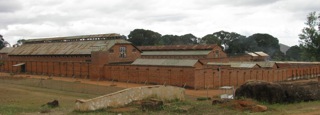
First Stop is Administration
Our first stop is the administrative offices where we deliver a number of new wheelchairs, as well as various medical supplies for the infirmary. We are introduced to the Chief Commissioner of Prisons McDonald L. Chaona, who is quite warm and cordial. At 50 years of age his imposing appearance commands the scene, yet his broad smile indicates his acceptance of the visitor. C. A. Kapala, National Prisons Chaplain is also on hand to express his appreciation for the medical supplies and wheelchairs from the Malawi Project. Both men are quick to indicate their need for the resources that have come their way. Both agree how badly they need these things in order to help improve prison conditions. Reports indicate a number of gallant efforts to educate the prisoners, as well as to assist them in gaining a trade, yet the fact remains that in a country with a near 50% unemployment rate it is hard for even the most qualified to find a job, let alone a man who has just been released from prison.
Current budgetary plans in the Malawi Parliament call for the construction of a new prison to replace this facility, but even with the best efforts this is still some time in the future, and with an rapidly increasing population throughout this part of Africa one can only hope prison construction will be able to outpace the need for new prison space. After a brief period with the administrative officials one of the men from the group escorts us on a tour inside the prison yards.
Like A Deserted, Rust Belt Factory
Entering the inner fence our mental image of a deserted property quickly changes. A guard opens the gate. He moves toward our car in order to inspect our credentials before allowing us to enter. Approaching slowly he looks intently at each of the passengers. Rolling down the driver’s side window an explanation is offered as to why we have come. Then from the back seat one of the prison officials identifies himself to the guard. He has come with us from the administration building in order to escort us on the tour. The guard salutes smartly and steps back. In spite of the conditions of the buildings we are very quickly impressed with the guards and prison officials we meet at this facility.
Reaching the Inside Gate
Entering the gate we pass a small building with a row of rifles standing at attention. If there was ever a doubt it goes away quickly. This is a maximum-security prison, the main one in the country, and the guards are capable of maintaining order when needed. Before coming to the site we read up on the conditions of Malawi’s prison system. Many of the prisons, including this one in Zomba were built during the colonial period. One of the prison officials notes that this prison was built in 1919 (however, my research indicates it was built in 1935), and was condemned in 1999. The lack of anywhere else to put the prisoners makes it impossible to close this facility. There is just no other facility, and no money to build it. Most of the prison system in Malawi were constructed during colonial times, and were planned primarily to hold prisoners for a short period of time. This particular prison was built to hold prisoners for a longer period of time, and it was under the control of the King’s African Rifles (KAR).
Problem is Evident
It isn’t long before the scope of the problem makes its full impact on the members of our team. One can only imagine how much capital it would take to make even a dent in the situation. Having been in the country for a number of years and understanding a little about economics, the high cost to upgrade the facility seems to be insurmountable. It is one thing to criticize the conditions in the hospitals and prisons in this resource poor part of the world, but it is a very different thing to learn the problems firsthand, and then figure out how to help solve them. No one wants conditions to remain as they are. Everyone wants to change it. No one has the funding to make it happen. Even the simplest of upgrades calls for funding that must come from some other program or need in the country.
Six Cell Blocks
The Zomba top-security prison has six different cellblocks, one for first time offenders, one for juvenile offenders, two for recurrent offenders, one for women, and one for condemned prisoners. No one has been executed during the offices of the past two presidents. The facility currently holds 2,000 prisoners even through some estimates indicate its capacity should be about 800 or 900. This overcrowding is similar to many of the hospitals in the country as well. There is just too much need and not enough money. Both hospitals and prisons face similar problems.
